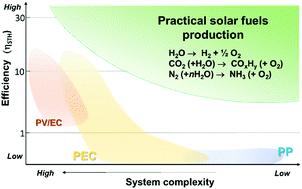当前位置:
X-MOL 学术
›
Energy Environ. Sci.
›
论文详情
Our official English website, www.x-mol.net, welcomes your
feedback! (Note: you will need to create a separate account there.)
Current density in solar fuel technologies
Energy & Environmental Science ( IF 32.4 ) Pub Date : 2021-10-11 , DOI: 10.1039/d1ee02512k Valentino Romano 1 , Giovanna D’Angelo 1 , Siglinda Perathoner 2 , Gabriele Centi 2
Energy & Environmental Science ( IF 32.4 ) Pub Date : 2021-10-11 , DOI: 10.1039/d1ee02512k Valentino Romano 1 , Giovanna D’Angelo 1 , Siglinda Perathoner 2 , Gabriele Centi 2
Affiliation

|
Solar-to-fuel direct conversion devices are a key component to realize a full transition to a renewable-energy based chemistry and energy, but their limits and possibilities are still under large debate. In this review article, we focus on the current density as a fundamental figure of merit to analyse these aspects and to compare different device configurations and types of solar fuels produced from small molecules such as H2O, CO2 and N2. Devices with physical separation of the anodic and cathodic zones, photoelectrochemical-type (PEC) or with a photovoltaic element integrated in an electrochemical cell (PV/EC), are analysed. The physico-chemical mechanisms involved in device operation that affect the current density and relations with device architecture are first discussed. Aspects relevant to device design in relation to practical use are also commented on. Then discussion is moved towards the relevance of these aspects to compare the behaviour in the state-of-the-art of the conversion of these small molecules, with focus on solar fuels from H2O, CO2 and N2 conversion, highligthing the gaps and perspectives of such technologies. The still significant lack of crucial data, notwithstanding the extensive literature on the topic, has to be remarked on, particularly in terms of the need to operate these cells in conjunction with sun concentration (in the 50–100 sun range) which emerges as the necessary direction from this analysis, with consequent aspects in terms of cell and materials design to operate in these conditions. The work provides a guide for the optimisation of the investigated technology and the fixing of their practical limits for large-scale applications.
中文翻译:

太阳能燃料技术中的电流密度
太阳能到燃料的直接转换装置是实现向基于可再生能源的化学和能源全面过渡的关键组成部分,但其局限性和可能性仍存在广泛争议。在这篇评论文章中,我们将电流密度作为一个基本的品质因数来分析这些方面,并比较不同的设备配置和由小分子(如 H 2 O、CO 2和 N 2)生产的太阳能燃料类型. 分析了阳极区和阴极区物理分离、光电化学型 (PEC) 或集成在电化学电池中的光伏元件 (PV/EC) 的设备。首先讨论影响电流密度的器件操作中涉及的物理化学机制以及与器件结构的关系。还评论了与实际使用相关的设备设计相关方面。然后将讨论转向这些方面的相关性,以比较这些小分子转化的最新技术,重点是来自 H 2 O、CO 2和 N 2 的太阳能燃料转换,突出这些技术的差距和前景。尽管有大量关于该主题的文献,但仍然严重缺乏关键数据,特别是在需要将这些电池与太阳集中度(在 50-100 太阳范围内)结合使用时该分析的必要方向,以及在这些条件下运行的电池和材料设计方面的相应方面。这项工作为优化所研究的技术和确定其大规模应用的实际限制提供了指导。
更新日期:2021-10-18
中文翻译:

太阳能燃料技术中的电流密度
太阳能到燃料的直接转换装置是实现向基于可再生能源的化学和能源全面过渡的关键组成部分,但其局限性和可能性仍存在广泛争议。在这篇评论文章中,我们将电流密度作为一个基本的品质因数来分析这些方面,并比较不同的设备配置和由小分子(如 H 2 O、CO 2和 N 2)生产的太阳能燃料类型. 分析了阳极区和阴极区物理分离、光电化学型 (PEC) 或集成在电化学电池中的光伏元件 (PV/EC) 的设备。首先讨论影响电流密度的器件操作中涉及的物理化学机制以及与器件结构的关系。还评论了与实际使用相关的设备设计相关方面。然后将讨论转向这些方面的相关性,以比较这些小分子转化的最新技术,重点是来自 H 2 O、CO 2和 N 2 的太阳能燃料转换,突出这些技术的差距和前景。尽管有大量关于该主题的文献,但仍然严重缺乏关键数据,特别是在需要将这些电池与太阳集中度(在 50-100 太阳范围内)结合使用时该分析的必要方向,以及在这些条件下运行的电池和材料设计方面的相应方面。这项工作为优化所研究的技术和确定其大规模应用的实际限制提供了指导。









































 京公网安备 11010802027423号
京公网安备 11010802027423号